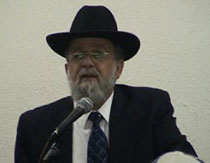Beit Midrash
- Torah Portion and Tanach
- Shmot
- Terumah
It intrigued me to learn that the Aron was actually three separate "boxes," each inside the other. The outer two were made of gold, the inner one of wood. At first it seemed to me that the Aron was somewhat deceptive, only appearing as if it was all pure gold, while in actuality having a wooden middle.
But then it was pointed out to me that G-d in his mercy took pity on those who would carry the Aron, & so He ordered that it not be made completely out of gold, which would make it tremendously heavy (gold is among the very heaviest of metals, 20 times heavier than water!).
The lesson to be learned here: Hashem never gives us a task too heavy to bear.
The Talmud (Yoma 72) has another spin on the multi-boxed construction: It learns from the Aron’s inner & outer layers of gold that a pious Jew should be "tocho k’boro", pure both inside & out. That is, his external persona, the one that the public sees, should be equally matched by his inner, private self; both should be "golden." Too often, we are mesmerized by someone’s superficiality, by his externals, & we fail to realize that a very different kind of person may lurk just beneath the surface.
In younger days, I attended many lectures by Isaac Bashevis Singer, the celebrated Yiddish author & Nobel Prize winner. I must tell you, he was a great inspiration to me; once he even took the time to share some of his insights into writing with me, urging me to first & foremost "tell the story" & let that - rather than fancy verbiage - always be at the heart of my work. I credited his influence in the forward to Shammas, the book of short stories I was privileged to write some years ago.
But later, I learned, sadly, that Singer was a pretty unsavory character, who had abandoned his first wife & son – who never forgave him – as well as the Orthodox lifestyle in which he was raised. The inner soul of the man, alas, was not nearly as golden as the genius without.
And if one has to choose between the inner & outer self? That’s a no-brainer. Clearly, what matters most is who we are on the inside. This we can learn from G-d’s famous directive in our Sedra, as we are charged to build His house: V’asu li Mikdash, v’shachanti b’tocham – Make me a holy place & I will dwell within you!"
At the end of the day it’s what’s inside that counts.

Parashat Hashavua: Gold, Silver, Precious Stones – Closeness to Hashem (part I)
Rabbi Yossef Carmel | Shevat 5785

The Divine Shechina and the levels of Kedusha
Parashat Teruma
Rabbi Shaya Karlinsky | Adar A, 5763

“Make for Me [an Aron] and I Will Dwell in Their Midst”
Rabbi Yossef Carmel | 5771





















